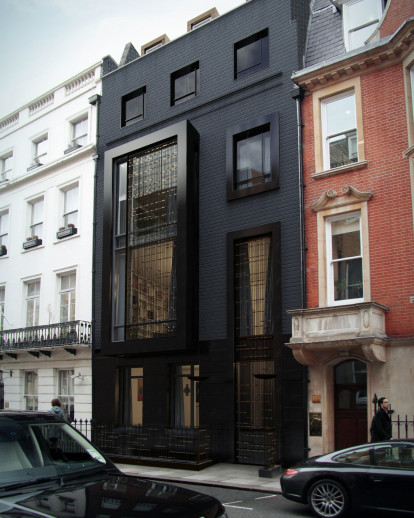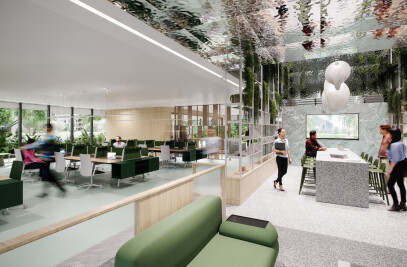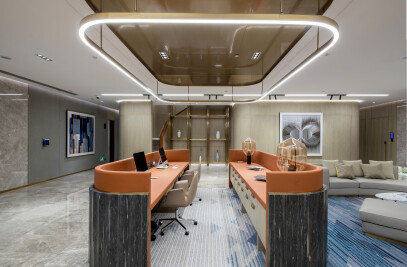Proposals for an elegant, new-build, black-fronted house in Mayfair’s Park Place, inspired by number ten Downing Street and designed by architects SHH, has now been granted planning permission by Westminster City Council, including change of use from Commercial B1 to Residential C3. The project is due to go on site in January 2014 for completion in the second half of 2015. The seven-storey property, located in the St James’s Conservation Area (where neighbouring buildings include The Economist Buildings, the Grade I-listed Brooks’ Club, the Grade-I listed Royal Overseas League and the Embassy of Equatorial Guinea), has been designed as a 21st-century interpretation of a traditional Mayfair home.
“The street already boasts a highly-eclectic mix of Georgian, Victorian and late 20th century buildings”, commented SHH Chairman and Project Director David Spence, “but the Victorian properties still dominate. We wanted to pay our respects to the building’s context and distilled the main elements of the street elevation to create its proportions, but at the same time we also sought to create a unique and stand-out contemporary property. The black brick frontage was inspired by number ten Downing Street, as a premier London address and visual icon, whilst the crafted metalwork, which will be a major design feature of the building’s street presence, along with contemporary versions of gaslights on either side of the entrance door, recalls the glamour of a grand late Victorian or arts & crafts Mayfair home.’
The existing 1960s property, which will be demolished, is an unsympathetic, purpose-built office, designed with a ‘pack and stack’ approach with an extra floor added in, making it at odds with the classic Victorian proportions of its neighbours.
The site is constrained by a seven-storey back wall to the southern aspect (backing onto Blue Ball Yard). SHH’s solutions to this include a new four-storey green wall to improve the rear outlook and soften the existing wall’s impact (with a recessed and lit stone panel at first floor level, directly facing a sliding wall and terrace for added light), as well as a rear profile which pulls away from the wall and steps in from the embassy building next door, with a rolling curved roof providing a glass curtain wall to help bring as much natural light as possible into the building, along with additional roof lights and recesses.
“Efficient use of the site and the maximisation of natural light ingress to the house were our priorities in the design” David Spence added. “The main habitable rooms are therefore located on the street side, where natural lighting is strongest, with mainly night-time usage rooms located to the rear, separated by a main circulation core. We were also able to be quite creative with the rear elevation of the property because it is not visible by the public and therefore subject to fewer constraints. This also allowed us to surmount the challenge of the dominant rear wall.”
SHH’s design includes a huge, double-storey contemporary version of an oriel bay window at the first and second floor levels, partly-fronted by a delicate metalwork screen both for privacy and added decorative value. The metalwork - to be used again for the street level railings, porch grille and entrance gate – is made up of antique bronze and brass with black iron uprights, whilst contemporary versions of gaslights will sit to either side of the glass entrance door.
A notable commitment to craftsmanship at the face of the building was vital to obtaining planning permission (in which SHH were assisted by specialists Nathaniel Lichfield &
Partners), as the area has a tradition of buildings with inherent artistic value. In fact, the Planning Committee of Westminster City Council unanimously agreed that the design is appropriate for its context, alongside the Grade I and 2* buildings in the road, and also praised the scheme for its interesting contemporary design, materials and contextual approach.
The dark materials palette for the scheme includes Fairface black bricks with charcoal pointing; polished granite for the oriel window bay; polished granite for the window portals and frames (with just the reveal in polished granite for the third floor windows) and charcoal black zinc for the standing seam roof. The whole ground floor level is made up of flamed-finish granite with bands and recesses, historically referencing Victorian rusticated entrance levels.
The interior layout includes a lobby, formal dining room, prep kitchen, receiving room/study, toilets, cloakroom, staircase and lift at ground floor level. On the first floor are located a formal reception room, family room, family kitchen, toilet, lift, stair and rear terraced area. On the second floor are the master suite with dressing rooms, wardrobes, bath and shower rooms, lift and stair, whilst the third floor is comprised of two further en suite bedrooms, linen and dressing rooms, with one of the bedrooms taking the form of a duplex space with sitting area and study space. The fourth floor contains the mezzanine level of bedroom three and a fourth en suite bedroom, along with the lift fore and an air-conditioning condenser room.
Below ground, a new triple basement includes a prep kitchen, laundry utilities and plant rooms and a staff suite at lower-ground level. At minus two level there are leisure facilities, which include a pool, spa and deck; lobby and changing rooms; steam and sauna rooms and a changing area with toilets and showers. A media room (with popcorn and drinks machines) and plant/service areas are proposed at minus three level.
Circulation for the scheme includes a lift through all levels, a dramatic internal stair from ground to fourth floor levels and an external stair leading from the ground to the lower ground levels at the front of the property.

































